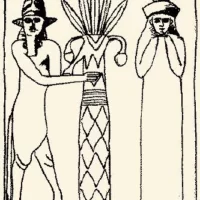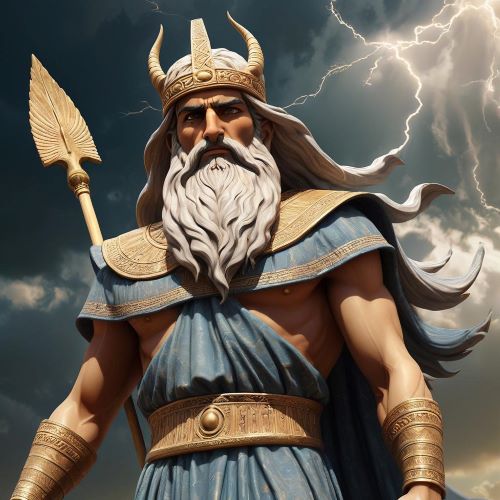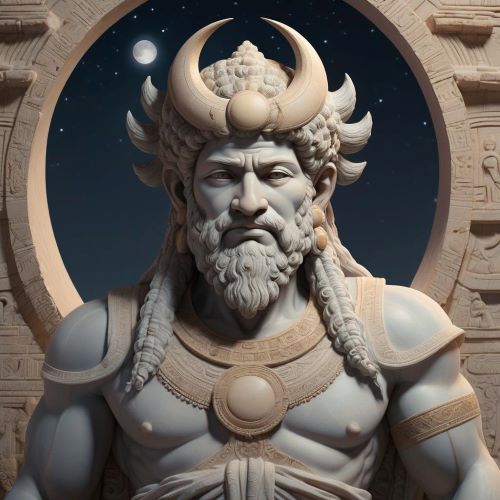Ninlil : Goddess of Wind
Listen
At a glance
| Description | |
|---|---|
| Origin | Sumerian Mythology |
| Classification | Gods |
| Family Members | Nisaba (Mother), Haya (Father), Nergal, Ninazu, Enbilulu, Ishum (Children) |
| Region | Iraq |
| Associated With | Wind, Destiny, Fertility |
Ninlil
Introduction
Ninlil, known as the “Lady of the Air,” was a central deity in Sumerian mythology whose divine authority extended across both the heavens and the earth. As the consort of Enlil, the chief god of air and storms, Ninlil represented harmony, cosmic justice, and the natural cycles of fertility and life. Her myths reflect the delicate balance between divine will and human destiny, making her one of the most spiritually complex goddesses of Mesopotamia. She is not only revered as a divine queen but also as a powerful force of renewal and continuity in the ancient Sumerian religious worldview.
Physical Traits
Although no single standardized image of Ninlil survives, Sumerian iconography and mythological texts offer glimpses into how she was perceived. She is typically portrayed as a serene and noble goddess, seated on a high-backed throne, a visual representation of her elevated status among the pantheon. Her horned crown was a symbol exclusive to deities, marking her divine authority. Flowing robes suggested her association with the wind and air, as did her symbolic link with celestial formations. These astral connections, particularly to constellations like Ursa Major and Lyra, emphasize her presence in the cosmos and reinforce her role as a goddess whose influence transcended earthly boundaries.
Family
Ninlil’s divine ancestry roots her in the most essential domains of Sumerian life. Her mother, Nisaba, was the goddess of writing and grain, while her father, Haia, oversaw storehouses—two domains central to civilization and sustainability. This divine heritage firmly placed Ninlil within the context of abundance, order, and preservation. Her union with Enlil was both romantic and symbolic, as their combined powers represented the synthesis of wind and earth, male and female, law and nature. Their children were deities of tremendous influence: Nanna, the moon god who governed time and cycles; Nergal, lord of the underworld and warfare; Ninazu, tied to healing and the transition between life and death; and others whose roles enriched the divine landscape. These connections reinforced Ninlil’s role as a maternal figure through whom divine lineage flowed.
Other names
Over time, Ninlil became known by a variety of names across regions and cultures. Before her divine marriage, she was called Sud, a goddess venerated in the city of Shuruppak. Once she joined Enlil, she assumed the title of Ninlil, which elevated her status in the broader Sumerian religious system. In Akkadian contexts, she was known as Mulliltu or Mullissu, names that emphasized her feminine connection to Enlil and suggested a merged divine persona. In Assyrian traditions, she was also associated with Šerua, a goddess of similar standing. Through cultural contact and interpretation, Herodotus and other Greek writers referred to her as Mylitta, aligning her with love goddesses like Aphrodite. These adaptations highlight the fluid nature of ancient theology, where core divine attributes could be reshaped to fit regional pantheons and evolving religious needs.
Powers and Abilities
Ninlil’s powers extended into several critical domains, making her a multidimensional figure in mythology. As the goddess of air, she governed the winds and their seasonal patterns, often seen as the bringer of fertility through rain-laden breezes. Her authority was not passive; she actively participated in shaping destinies alongside Enlil. The two were viewed as divine judges who decreed fates for both mortals and gods, and their decisions formed the backbone of Mesopotamian cosmic law. Her association with fertility was deeply rooted in the agricultural cycles that sustained Sumerian life, symbolized by motifs like grain and barley. In addition, her descent into the underworld in mythic texts gave her a dual aspect: a life-giving goddess who also understood death and regeneration. This duality made her relatable to human experiences of joy, grief, motherhood, and perseverance.
Modern Day Influence
Although active worship of Ninlil ceased with the fall of Mesopotamian city-states, her memory has endured through scholarship, art, and neo-spiritual interpretations. She continues to be a subject of academic interest, especially within the fields of comparative mythology, ancient religion, and feminist theology. Her stories and roles are examined not only to understand Sumerian beliefs but also to appreciate the origins of goddess worship and maternal archetypes in later cultures.
In modern spiritual circles, particularly among neo-pagan and goddess-centered movements, Ninlil is often invoked as a symbol of inner strength, balance, and the interconnectedness of nature and spirit. Artists and writers find inspiration in her narrative—particularly in her dignified resilience and her partnership with Enlil—as a means to explore themes of autonomy, justice, and feminine power. Her image and mythology have been adapted in literature, video games, graphic novels, and poetry, where ancient deities are reimagined for contemporary audiences.
Cultural institutions and museums across the globe preserve artifacts, inscriptions, and tablets that feature Ninlil or reference her in mythological texts. Digitized collections allow broader access to her legacy, ensuring that this powerful goddess remains a part of global heritage discussions. Even in fiction, authors often draw upon her attributes—air, destiny, rebirth—to inform characters or storylines with mythological depth.
Related Images
Source
Brisch, N. (2019). Ninlil (Mulliltu, Mullissu, Mylitta). Ancient Mesopotamian Gods and Goddesses. Oracc and the UK Higher Education Academy. Retrieved from https://oracc.museum.upenn.edu/amgg/listofdeities/ninlil/index.html
Dalley, S. (1979). d NIN.LÍL = Mullissu. Journal of Near Eastern Studies.
Krebernik, M. (1998–2001). Ninlil. In Reallexikon der Assyriologie und Vorderasiatischen Archäologie.
Encyclopaedia Britannica. (2024). Ninlil. Retrieved from https://www.britannica.com/topic/Ninlil
Mythology Worldwide. (2024). The Cult of Ninlil: Goddess of Air and Wind in Mesopotamian Religion. Retrieved from https://mythologyworldwide.com/the-cult-of-ninlil-goddess-of-air-and-wind-in-mesopotamian-religion/
World Mythos. (2024). Ninlil: Sumerian Goddess of Wind and Fertility. Retrieved from https://worldmythos.com/ninlil/
Wikipedia contributors. (2024). Ninlil. Wikipedia. Retrieved from https://en.wikipedia.org/wiki/Ninlil
Frequently Asked Questions
What is lorem Ipsum?
I am text block. Click edit button to change this text. Lorem ipsum dolor sit amet, consectetur adipiscing elit. Ut elit tellus, luctus nec ullamcorper mattis, pulvinar dapibus leo.
What is lorem Ipsum?
I am text block. Click edit button to change this text. Lorem ipsum dolor sit amet, consectetur adipiscing elit. Ut elit tellus, luctus nec ullamcorper mattis, pulvinar dapibus leo.
What is lorem Ipsum?
I am text block. Click edit button to change this text. Lorem ipsum dolor sit amet, consectetur adipiscing elit. Ut elit tellus, luctus nec ullamcorper mattis, pulvinar dapibus leo.
What is lorem Ipsum?
I am text block. Click edit button to change this text. Lorem ipsum dolor sit amet, consectetur adipiscing elit. Ut elit tellus, luctus nec ullamcorper mattis, pulvinar dapibus leo.
What is lorem Ipsum?
I am text block. Click edit button to change this text. Lorem ipsum dolor sit amet, consectetur adipiscing elit. Ut elit tellus, luctus nec ullamcorper mattis, pulvinar dapibus leo.













